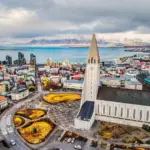From Shanghai to Stockholm, these are the world's greatest public transport systems – as voted by the people who use them every day
Where would we be without public transportation? Our world is increasingly dominated by cities that grow every day, and more and more of us are realizing that ever-increasing car traffic is bad news for us, our cities, and the planet. In this context, trains, buses, and trams are the unsung heroes that could literally save the world.
Of course, a crowded bus in morning commute is not exactly the dream travel experienceBut when it comes to exploring the world's greatest cities, it all comes down to hopping on a train or bus and discovering the city through a local's eyes. And some of the world's best public transportation networks even double as cultural scavenger hunts, transforming the mundane into something spectacular with sublime art and design.
The Best Public Transport in the World

1. Berlin
Comfortable, safe, and always punctual, Berlin's public transportation is a marvel. So it's no surprise to see the city take first place here, with 97 percent of Berliners praising their city's transportation network. Residents and travelers have been making the most of the U-Bahn, S-Bahn, and buses for decades—even when the city was divided in two during the Cold War. The underground U-Bahn is particularly enchanting, an efficient maze of trains that transport people from attraction to attraction from morning to night. With an impressive 175 stations spread across nine lines, it may seem imposing, but the U-Bahn is magnificently simple to navigate.

2. Prague
The capital of the Czech Republic is one of the most beautiful cities in Europe, and its public transportation network only adds to that. In our survey, an impressive 96 percent of Prague residents said it was easy to get around the city using public transportation. And it's not just convenient, it's also spectacular. Prague wouldn't be Prague without the sight of a tram passing in front of a Gothic church or a Renaissance beauty—but the metro is even better, with three easy-to-use lines covering almost the entire city. Each line has its own aesthetic character, from the photogenic bubble-shaped facades of Line A (green) to the futuristic designs found at the end of Line C (red). The yellow Line B encompasses both styles, with some curious remnants of the communist period for those interested in that era.

3. Tokyo
New York has more stations, Shanghai has more tracks, but no public transportation system on the planet serves as many people as Tokyo. You may have seen viral videos of crowded subway trains in the Japanese capital, and such sights are not uncommon. Furthermore, the sheer size of the network makes it something of a maze. However, Tokyo's public transportation is brilliantly maintained and increasingly user-friendly for non-Japanese speakers (apart from locals, 94 percent of whom said the city was easy to navigate using public transportation). It might be best to avoid rush hour, though…

4. Copenhagen
It's easy to argue that Copenhagen is the best city on the planet. Few places are as elegantly stylish as the Danish capital, and its selection of restaurants, museums, and bars is unmatched (not to mention the craft beer). Public transportation in Copenhagen delivers on its promise, with a reliable system of trains, buses, and boats transporting people all day long. You can pay for everything with a single ticket: the Copenhagen Card covers public transportation throughout the city. It's no wonder that 93 percent of locals said it was easy to get around.

5. Stockholm
Unsurprisingly for this capital of Scandinavian design, Stockholm's metro is the most stylish thing around. They don't call it a art gallery The world's longest for no reason: the overwhelming majority of Stockholm's tunnel stations shine with creativity, from mosaics to paintings covering all sorts of themes. But aesthetics are only part of the package: public transportation in Stockholm (including trams, buses, and ferries) is as efficient as it is engaging. And 93 percent of locals agree that getting around the city is easy.

6. Singapore
It should come as no surprise to hear that public transportation in Singapore is far ahead of the modern world. Innovation is standard here, and the city's buses and mass rapid transit (MRT) subway leave no stone unturned in their pursuit of excellence. The MyTransport.SG app makes planning a breeze, the Singapore Tourist Pass takes care of payment, and almost all of Singapore's top attractions are within walking distance of a station. Oh, and did we mention that all buses are wheelchair accessible and strollers are allowed? Singapore gets a lot of things right, and public transportation is right up there, according to 92 percent of locals.

7. Hong Kong
Hong Kong's public transportation routinely ranks high among the best in the world, and rightly so. The network is extensive, to say the least, and the city prides itself on the fact that 75 percent of the population lives within a kilometer of a subway station—that's less than a 15-minute walk. The entire system is efficient, clean, and comfortable, and the Octopus card makes payment delightfully simple. Getting used to the system isn't immediate, but the effort is definitely worth it. Locals agree: in our survey, 92 percent of Hong Kongers praised their city's transportation system. To get the most out of Hong Kong, make the most of your public transportation.

8. Taipei
Taiwan's capital is one of the most livable cities in the world, and its wonderful public transportation system is a key reason. The Taipei Metro (or MRT) is one of the busiest light rail systems in the world, but not a shred of efficiency has been sacrificed in the process. Taipei is one of the most easily navigated cities in Asia, with 92 percent of locals rating the public transportation network positively, and the elevated stations provide visiting commuters with a fascinating glimpse into everyday street life. The English-language signs are also certainly helpful.

9. Shanghai
Second only to New York City in terms of number of stations, the Shanghai subway is the largest in the world when it comes to distance. In fact, the Shanghai subway system was modeled after its famous contemporary in New York City, and unlike its American counterpart, China's most populous city maintains its system rigorously on time. Along with trains, Shanghai's bus, maglev, taxi, and ferry system can be paid for using the Shanghai Public Transportation Card, a contactless version of a prepaid card that can be purchased and recharged at ticket offices. Shanghai residents are certainly satisfied: 91 percent of respondents in our survey said it was easy to get around the city using public transportation.

10. Amsterdam
You'll certainly notice the throngs of bicycles crisscrossing the Dutch capital, but you don't need to commit to two wheels here: Amsterdam's public transportation covers a lot of ground, and not a little water, either. The city's network of trains, trams, ferries, and buses does an exceptional job, and the entire system offers excellent value—it's no wonder that 91 percent of locals praised the city's public transportation system in our survey. Download the GVP travel app before your visit and explore all the city has to offer.

11. London
Getting 91 percent of Londoners to agree on something is no easy feat, but the people of the Big City have come together to celebrate the majesty of London's public transport system. Okay, that might be a bit of an exaggeration, but the numbers don't lie: London's buses, trains, and underground are easy to use and surprisingly efficient, not to mention aesthetically iconic. The London Underground is the standout (and the star of countless films and TV shows), but the city's beloved red double-decker buses are also much loved. Add the driverless Docklands Light Railway (and the commuter hero London Overground), and you have a system worth celebrating. A visitor's Oyster card also doubles as a stylish souvenir.

12. Madrid
Madrid's public transportation system is one of the most comprehensive in Europe—in fact, 89 percent of the city's population lives within a kilometer of a station. Coincidentally or not, 88 percent of the Madrileños we interviewed are satisfied with the city's public transportation network. In addition to the metro, the system includes light rail, buses, and regional trains, and a variety of tickets are available—with the Cercanías trains currently free for regular passengers. Staying for a while? Get a monthly pass. Want to travel around the city over the course of a few days? A 10-ride ticket should do the trick.

13. Edinburgh
Oh, Edinburgh, you are enchanting. The Scottish capital is one of the UK's most beautiful cities, with grand architecture and an inviting atmosphere that defines the term 'convivial.' And while Edinburgh is extremely walkable, the city's public transportation is also fantastic, with easy-to-use buses crisscrossing the city day and night. In our survey, a solid 88 percent of locals said it was easy to get around using public transportation. The trams may not be as iconic as others in the north of Britain (and are not without controversy locally), but they more than do the job. The Transport for Edinburgh (TfE) app will be your new best friend here.

14. Paris
The word 'iconic' gets thrown around a lot, but the Paris Métro is an iconic symbol of one of the most iconic cities on the planet. It's the second-busiest metro system in Europe (Moscow takes first place), a densely built network spanning over 300 stations on 16 lines. Some of these stations are attractions in their own right, from the history-filled walls of the Bastille to the almost steampunk vibes of Arts et Métiers. Métro 1 covers the classic tourist spots, while Métro 6 runs primarily above the soil and offers Seriously impressive views. And while the Métro gets most of the attention, public transportation in Paris also includes buses, trams, and regional trains, including the pioneering RER. In our survey, 84 percent of locals gave the green light to public transportation in Paris.

15. New York
New York City's public transportation has its critics—including many New Yorkers—and much of it is well-founded. The subway isn't exactly the cleanest, and the idea of punctuality seems to have been abandoned, with years of underfunding becoming increasingly evident. But unless you have hours to spare to roam the streets (and a truly comfortable pair of shoes), there's still no better way to get around New York than its public transportation system. The subway is the largest in the world by number of stations, and the extensive bus system makes exploring easy, even away from the tracks. Plus, there's something iconic about riding the subway in New York, if you embrace its quirks. New Yorkers certainly do: despite everything, 83 percent of them said it was easy to get around the city using public transportation.

16. Montreal
Montreal, Montreal. Canada's second-largest city is a delight to explore, whether on foot or via Montreal's well-developed public transit system. The latter makes the former easier, of course—83 percent of Montrealers say the city is easy to navigate via public transit—so familiarize yourself with the bus and the modern, rubber-wheeled Métro. make the most of your trip. A variety of tickets are available for multi-day trips, and small humans under 11 years of age travel for free. The Société de Transport de Montréal website also has itineraries detailed to explore the city by public transport.

17. Chicago
Chicago's public transportation system may not be perfect, but the Chicago Transit Authority (CTA) does a good job maintaining the city's eight 'L' (short for 'elevated') train lines, as well as 129 bus routes. They've introduced innovations like regenerative braking without compromising efficiency. And public satisfaction is almost as high as in New York: according to our survey, 82 percent of Chicagoans have positive things to say about their city's network.

18. Beijing
Beijing is one of the most populous cities in the world, China's most congested urban center, and a veritable 24-hour metropolis. Given the size and scope of the Chinese capital, it's no small feat that 81 percent of Beijingers express satisfaction with the quality and efficiency of public transportation there. Road congestion is no surprise, making the subway the most popular form of public transportation here, with over 500 miles of track spread across 27 lines and nearly 500 stations. The network is constantly growing, with buses, trolleybuses, and trains also moving throughout the city daily.

19. Mumbai
Have you ever been to Mumbai without spending some quality time on the city's local trains? It's quite an experience, though it's probably best avoided during rush hour unless you're a veteran of such situations. Still, 81 percent of locals say it's easy to get around Mumbai using public transport, and the system certainly keeps the metropolis moving, with millions of people using the city's buses, auto rickshaws, metro, and taxis daily. The city also introduced the Chalo Pay app—a pioneer in Indian public transport—making everything a little easier. Download the M-indicator app to keep track of the schedules and let Mumbai unfold before you.
With content from timeout.com/
Lucas Wanderlust has a tireless spirit of adventure, always seeking new travel experiences. Fascinated by the world and the possibility of exploring unknown destinations, he fell in love with the sense of freedom and self-discovery that traveling alone provides. With a backpack on his back and a heart open to the unknown, Lucas embarks on exciting journeys, where each destination becomes a unique chapter in his life story. He gives himself body and soul to the magic of solo travel, inspiring others to follow in his footsteps and discover themselves through adventure.







